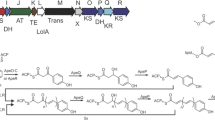Abstract
Pseudomonas aeruginosa is able to utilize leucine/isovalerate and acyclic terpenes as sole carbon sources. Key enzymes which play an important role in these catabolic pathways are 3-hydroxy-3-methylglutaryl-coenzyme A (CoA) lyase (EC 4.1.3.4; HMG-CoA lyase) and the 3-hydroxy-3-isohexenylglutaryl-CoA lyase (EC 4.1.2.26; HIHG-CoA lyase), respectively. HMG-CoA lyase is encoded by the liuE gene while the gene for HIHG-CoA lyase remains unidentified. A mutant in the liuE gene was unable to utilize both leucine/isovalerate and acyclic terpenes indicates an involvement of liuE in both catabolic pathways (Chávez-Avilés et al. 2009, FEMS Microbiol Lett 296:117–123). The LiuE protein was purified as a His-tagged recombinant protein and in addition to show HMG-CoA lyase activity (Chávez-Avilés et al. 2009, FEMS Microbiol Lett 296:117–123), also displays HIHG-CoA lyase activity, indicating a bifunctional role in both the leucine/isovalerate and acyclic terpenes catabolic pathways.



Similar content being viewed by others
References
Aguilar JA, Zavala AN, Díaz-Pérez C, Cervantes C, Díaz-Pérez AL, Campos-García J (2006) The atu and liu clusters are involved in the catabolic pathways for acyclic monoterpenes and leucine in Pseudomonas aeruginosa. Appl Environ Microbiol 72:2070–2079
Aguilar JA, Díaz-Pérez C, Díaz-Pérez AL, Rodríguez-Zavala JS, Nikolau BJ, Campos-García J (2008) Substrate specificity of the 3-methylcrotonyl-CoA and geranyl-CoA carboxylases from Pseudomonas aeruginosa. J Bacteriol 190:4888–4893
Chávez-Avilés MN, Díaz-Pérez AL, Reyes de la Cruz H, Campos-García J (2009) The Pseudomonas aeruginosa liuE gene encodes the 3-hydroxy-3-methylglutaryl-coenzyme A lyase, involved in leucine and acyclic terpene catabolism. FEMS Microbiol Lett 296:117–123
Díaz-Pérez AL, Zavala-Hernández NA, Cervantes C, Campos-García J (2004) The gnyRDBHAL cluster is involved in acyclic isopreoid degradation in Pseudomonas aeruginosa. Appl Environ Microbiol 70:5102–5110
Forster-Fromme K, Chattopadhyay A, Jendrossek D (2008) Biochemical characterization of AtuD from Pseudomonas aeruginosa, the first member of a new subgroup of acyl-CoA dehydrogenases with specificity for citronellyl-CoA. Microbiology 154:789–796
Forster-Fromme K, Höschle B, Mack C, Armbruster MW, Jendrossek D (2006) Identification of genes and proteins necessary for catabolism of acyclic terpenes and leucine/isovalerate in Pseudomonas aeruginosa. Appl Environ Microbiol 72:4819–4828
Forster-Fromme K, Jendrossek D (2006) Identification and characterization of the acyclic terpene utilization gene cluster of Pseudomonas citronellolis. FEMS Microbiol Lett 264:220–225
Forster-Fromme K, Jendrossek D (2008) Biochemical characterization of isovaleryl-CoA dehydrogenase (LiuA) of Pseudomonas aeruginosa and the importance of liu genes for a functional catabolic pathway of methyl-branched compounds. FEMS Microbiol Lett 286:78–84
Hosokawa Y, Shimomura Y, Harris RA, Ozawa T (1986) Determination of short-chain acyl-coenzyme A esters by high-performance liquid chromatography. Anal Biochem 153:45–49
Martin RR, Marshall VD, Sokatch JR, Unger L (1973) Common enzymes of branched-chain amino acid catabolism in Pseudomonas putida. J Bacteriol 115:198–204
Sambrook J, Russell DW (2001) Molecular cloning: a laboratory manual, 3rd edn. Cold Spring Harbor Laboratory Press, Cold Spring Harbor
Seubert W, Fass E (1964) Studies on the bacterial degradation of isoprenoids. IV. The purification and properties of beta-isohexenylglutaconyl-CoA hydratase and beta-hydroxy-beta-isohexenylglutaryl-CoA lyase. Biochem Z 341:23–34
Wong SM, Mekalanos JJ (2000) Genetic footprinting with mariner-based transposition in Pseudomonas aeruginosa. Proc Natl Acad Sci USA 97:10191–10196
Acknowledgments
This research was funded from grants CONACYT (P-46547-Z), C.I.C.-UMSNH 2.14, and COECyT CB070229-2 to JCG. M. Chávez-Avilés was supported by a fellowship from CONACYT.
Author information
Authors and Affiliations
Corresponding author
Rights and permissions
About this article
Cite this article
Chávez-Avilés, M., Díaz-Pérez, A.L. & Campos-García, J. The bifunctional role of LiuE from Pseudomonas aeruginosa, displays additionally HIHG-CoA lyase enzymatic activity. Mol Biol Rep 37, 1787–1791 (2010). https://doi.org/10.1007/s11033-009-9611-6
Received:
Accepted:
Published:
Issue Date:
DOI: https://doi.org/10.1007/s11033-009-9611-6




